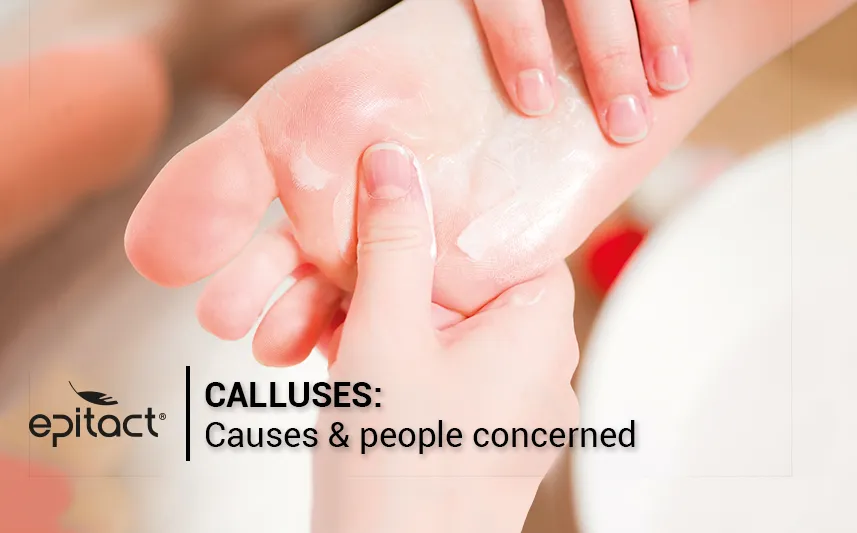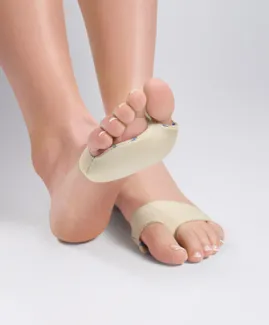
Find out what causes calluses on feet and who is more likely to develop them.
Your skin thickens, hardens and becomes yellow in some spots of your sole, especially in the ball of your foot? You’re probably dealing with foot calluses... Even if some solutions can stop the process, it is even more simple to treat the causes of calluses. Read this guide to understand why do people get calluses on feet and how to prevent their formation!
What are the causes of calluses on feet?
A callus forms after repeated rubbing and pressure on a small skin area, usually on the feet and hands. By treating the cause, you would avoid the callus to reappear.
Regarding the feet, the main cause of such pressure and friction is related to the shoe. Indeed, wearing shoes with bulky seams, poorly adjusted straps, high heels or tight and narrow shoes can create skin irritation. What causes calluses on their feet are also thick socks that put pressure against your foot and favour the development of calluses.
However, many other risk factors can cause excessive pressure on the foot and play a role in the formation of thickened areas of skin. Discover now why some people get calluses more easily.
Why do some people get more calluses than others?
Without going as far as talking about predisposition, some factors can favour the development of calluses. Everyone can have a callus, but why do some people get calluses that appear or reappear constantly?
Dry skins
Having dry skin is one of the main cause of calluses on feet. Indeed, dry skins lack moisturising so they are more fragile, sensitive and less resistant to stresses. Moreover, having a dry skin helps the formation of hard and dead skin and cracks! By the way, a moisturised skin is more supple and limits the onset of hyperkeratosis (abnormal thickening of skin) and pain.
Age: an important cause of calluses on feet
Age also seems to be involved in the development of calluses: the cell regeneration is less active and the skin is weaker, often drier. Moreover, the sole of the foot is covered by a layer of fatty tissue (the plantar fat pad) that cushions the shocks between the foot and the ground. Overtime, this tissue becomes thinner and less effective at absorbing pressure.
Thin and overweight people
Calluses develop more easily in thin and overweight or obese people. Indeed, the bony prominences in thin people are more pronounced. As a result, pressures on these areas can be high and lead to intense irritations. On the contrary, being overweight induces more pressure on the joints of the foot, particularly under the ball of the foot which supports a great part of the body weight.
Some daily activities
Also, like any repeated pressure, playing certain instruments regularly may cause calluses on your feet or hands! For example, prolonged activities that involve strict positions can lead to calluses on the hands. Some manual work or sports (holding a tennis racket, a golf club, a tool...) can also cause calluses on the palm of the hands, at the base of the fingers. In addition, sports like running or hiking increase the risk of causing calluses on feet.
Specific foot shapes are another cause of foot calluses
Calluses can also result from a foot deformity or non-physiological movements of the foot. Those foot problems change the distribution of load supported by the different parts of the foot. As a result, some weight bearing areas are overwhelmed and face excessive pressure which can cause calluses on feet.
To deal with this, your podiatrist can perform a check-up to analyse your foot shape and position and then to correct them with custom-made orthopaedic insoles. Thanks to that, the areas that bear excessive weight are eased and the formation of calluses is limited.
What solutions against calluses?
To relieve pain and improve your comfort, EPITACT® has developed a solution made up of silicone gel that has the same properties as the natural fat pad. Therefore, the metatarsal pads* are very helpful to distribute the pressure and to protect from rubbing. They are ultra-thin and soft so that you can wear in any type of shoes. They will prevent or relieve your foot callus.
Other treatments for calluses include foot care. Firstly, moisturise your skin regularly and then remove dead skin with a pumice stone after soaking your foot in warm water.
You have discovered why some people get calluses more easily than others and what are the causes of calluses on feet. Find more information about the symptoms of a callus and how to remove it permanently in our next articles.
*This solution are class I medical device that bears the CE marking under this regulation. Carefully read the instructions before use. Manufacturer: Millet Innovation. 09/2021
 Pharmacie
Pharmacie